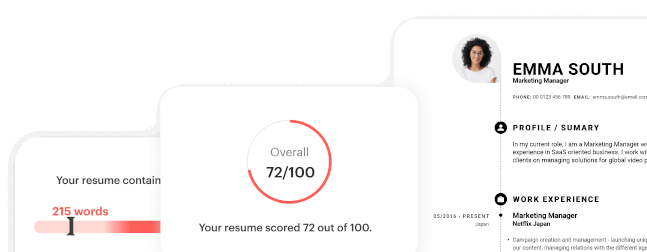Creating a standout mechanical engineer resume just got easier. We're here with practical tips, examples that speak volumes, and templates that save you time. Let's get your skills and experience out there for recruiters to see!
In this guide, we'll teach you how to perfectly encapsulate your mechanical engineering experience on a resume. Keep reading to learn all about:
- Choosing the best resume format for your experience as a mechanical engineer
- Writing a resume summary that showcases your accomplishments
- Selecting key mechanical engineering skills that demonstrate your expertise
- Describing work experience with specific and quantifiable details
- Listing your mechanical engineering education properly on a resume
- Accessing the best job search resources for mechanical engineers
Still looking for a job? These 100+ resources will tell you everything you need to get hired fast.
1. Choose the best resume format for your experience as a mechanical engineer
The first big decision to make when crafting a mechanical engineer resume is which format to use.
Generally, the reverse-chronological resume is the standard format expected by mechanical engineering employers. This format focuses on work experience primarily, listing your most recent job first and working chronologically backward from there.
However, if you are a recent graduate or otherwise lack relevant work experience, the reverse-chronological format may not suit your needs as well as an alternative format. In this case, consider using one of the following less-common formats:
- The functional resume: Functional resumes focus on education, skills, and unpaid experience rather than formal work experience. This format is well-suited for recent or soon-to-be graduates who have a high level of academic experience but a limited work history.
- The hybrid resume: Hybrid resumes combine elements of both functional and reverse-chronological formats, spreading the focus of the document out evenly between all sections. This format works well for applicants who are changing career paths or have large gaps in their employment histories.
Choose your preferred template and make your resume shine.
2. Craft a resume summary that showcases your accomplishments
Your resume summary is a short statement that starts off your resume. Typically between one to three sentences in length, this summary should focus on your very best skills, experience, and accomplishments.
The purpose of the resume summary is to grab the attention of potential employers. In just a few sentences, you should convey the value you provide as an employee and what types of accomplishments and key abilities you bring to the table.
To demonstrate how to write an effective summary, we have included a weak example below, followed by a correction and explanation.
Incorrect mechanical engineer resume summary example
Experienced Mechanical Engineer with a strong background in designing new tool prototypes and implementing new industrial processing systems. Previous experience in a leadership position, with the goal to leverage this experience in a lead role at a technology company.
Why is this incorrect?
In this example, the applicant includes some key details about their experience and specialized expertise. However, rather than describing themselves as “experienced,” they should include the specific years of experience they hold, as well as include greater context around the leadership position they worked in.
Remember – you should aim to show experience through quantifiable details rather than simply telling an employer vague facts.
Corrected mechanical engineer resume summary example
Efficient Mechanical Engineer with 6+ years of experience designing tool prototypes and implementing new industrial processing systems. Worked as the Lead Engineer for a major year-long project in a previous position, executing the implementation of a new equipment layout and workflow process that increased year-over-year productivity by nearly 35%.
Why is this correct?
In this corrected example, the applicant is far more clear with the details they provide. Rather than simply stating they held a leadership position, they give much greater context about the type of position and project they worked on, including a key accomplishment of increasing productivity by a significant percentage.
3. Select effective mechanical engineering skills that demonstrate your expertise
Including a skills section on your resume is a great way to briefly include your specific areas of expertise that may have been overlooked in your summary or work experience section.
Additionally, your skills section can provide excellent talking points during interviews, as well as give a potential employer a broader overview of you as a professional. As such, it is crucial to only include skills you can expand upon in an interview if asked.
When selecting your skills for your resume, aim to include a variety of both technical and interpersonal abilities. This will show employers that you understand that people skills (interpersonal) are just as important as learned skills (technical).
The best technical skills to put on your mechanical engineer resume
- MATLAB
- CAD/AutoCAD
- Proficiencies in computer programs (Microsoft Office 360, Adobe Suite, etc.)
- Designing and interpreting blueprints
- Conducting industry research
- OSHA safety standards
- Robotics & artificial intelligence
- Manufacturing processes
- Mathematics
- Prototyping
Effective interpersonal skills for your mechanical engineer CV
- Analytical skills
- Critical thinking
- Problem-solving
- Creativity
- Collaboration
- Written & verbal communication
- Excellent organization
- Time management
- Adaptability
- Leadership
4. Describe your work experience with specific and quantifiable details
Your work experience section on a resume should always encapsulate both your previous responsibilities and on-the-job accomplishments with as many specific details as possible.
When choosing which descriptive bullet points to use, choose to include information that is quantifiable and shows clear value to employers. The person reading your resume should be able to easily skim through this section and gain a good understanding of your professional experience.
Here is an example of a work experience entry from a mechanical engineer resume
ABC Technologies, Miami, FL
Mechanical Engineer
August 2017 to June 2020
- Implemented a new equipment layout that optimized productivity, leading to a 10% increase in overall production capacity.
- Designed technical drawings for 15+ corporate clients, resulting in an average 15% increase of industrial input across these clients’ businesses.
- Maintained an exceptionally low production error rate, averaging at less than 2% monthly.
5. List your mechanical engineering education properly on a resume
The general standard educational requirement to become a mechanical engineer is a bachelor’s degree. This level of education will earn you entry-level positions, as well as some higher-level positions if you have adequate experience.
Of course, if you have any higher degrees than a bachelor’s, these can help make your resume more competitive and eye-catching to employers. Make sure to always list your highest degree first in your education section!
Here is an example of a well-crafted education section on a mechanical engineer resume
Education
Georgia Institute of Technology, Atlanta, GA
M.S. in Mechanical Engineering
Graduated: 2018, Summa Cum Laude
Georgia Institute of Technology, Atlanta, GA
B.S. in Mechanical Engineering
Graduated: 2015, Magna Cum Laude
- President of the Student Engineering Association — 2014 to 2015
6. Include relevant extra sections in your mechanical engineer resume
Including extra sections in your mechanical engineer resume can provide valuable information that sets you apart from other candidates.
These sections allow you to showcase additional qualifications, accomplishments, and relevant experiences that demonstrate your expertise and potential contributions to prospective employers. By strategically incorporating these extra sections, you can provide a comprehensive and well-rounded representation of your capabilities as a mechanical engineer.
One such extra section to consider is Professional Affiliations and Memberships. This section highlights your active involvement in professional organizations related to mechanical engineering.
Professional Affiliations and Memberships
Member, American Society of Mechanical Engineers (ASME), 2017-Present
- Actively participate in technical conferences and networking events, staying up-to-date with the latest industry trends and advancements.
Another valuable extra section is Publications and Presentations. If you have authored technical papers or delivered presentations in your field, this section allows you to showcase your thought leadership and expertise.
Publications and Presentations
Co-author, "Advancements in Renewable Energy Technologies," International Conference on Sustainable Engineering, 2020
- Presented findings on the integration of solar energy in HVAC systems, highlighting potential cost savings and environmental benefits.
Adding these extra sections not only provides additional depth to your mechanical engineer resume but also demonstrates your proactive engagement in your field and showcases your ability to contribute to the industry's advancement.
7. Top job search resources for mechanical engineers
In the competitive job market for mechanical engineers, knowing where to look for opportunities can kickstart your career journey. Here's a round-up of some of the best job search resources for mechanical engineers:
- Engineering job boards: Websites like Engineering.com are tailored to the engineering field and can target your job search to mechanical engineering roles.
- LinkedIn: This professional networking site is a treasure trove of job opportunities. Don't forget to utilize its job search functionality and set up alerts for mechanical engineer roles.
- Industry associations: Associations like the American Society of Mechanical Engineers (ASME) often post job openings in the field and can be a great resource for networking as well.
- Recruitment agencies: Specialist recruiters like Aerotek, Randstad Engineering, and Kelly Services often post job listings for mechanical engineers and provide additional career guidance.
- Job fairs: Universities, industry associations, and even large tech conferences host career fairs that can be a good source of job opportunities. Consider attending to network with potential employers.
Remember, a successful job search combines proactive networking, targeted job applications, and ongoing skill improvement. Good luck!
Mechanical Engineer Resume FAQ
The focus should be on showcasing your technical skills, relevant work experience, and project accomplishments. Any special certifications or training should also be highlighted.
An objective statement can instantly give the employer a brief understanding of your career goals. If well-crafted, it can compel them to read the rest of your resume.
Only if the interests or hobbies are relevant to the job or showcase transferable skills. Otherwise, it's better to utilize the space for your skills and experiences.
Start with your most recent job and work backwards. For each job, provide a brief summary of your role and a bullet point list of your responsibilities and accomplishments.
Use action verbs, quantify achievements where possible, and tailor your resume to each job application by including relevant keywords from the job description. A clean, clearly-formatted resume also helps leave a positive impression.





































![How to Write a Professional Resume Summary? [+Examples]](https://d2xe0iugdha6pz.cloudfront.net/article-small-images/i-Profile.svg)
![How to Put Your Education on a Resume? [+Examples]](https://d2xe0iugdha6pz.cloudfront.net/article-small-images/i-Collage-Universities.svg)
![How to Describe Your Work Experience on a Resume? [+Examples]](https://d2xe0iugdha6pz.cloudfront.net/article-small-images/Experience.svg)


